Introduction
Thank you, Matthew. It is a real privilege – and not a little daunting – to be invited onto this stage to talk about farming with so many people who have lived on the land all their lives. I would like to thank all the farmers – many of them in this hall – who have welcomed me onto their land over the last year and patiently educated me in the history, economics, and culture of our farms and farming communities.
The National Food Strategy is due to publish an interim report in the spring and a final strategy in the winter. Our scope is intentionally broad – you might think insanely broad, and in the dark hours just before dawn I sometimes think about that too. We have been asked to set out what needs to be done – across all departments of government and in society more broadly – to build a robust food system that provides good affordable food to everyone; restores the environment; maintains our countryside; brings good jobs to our communities – rural and urban; and stops making us sick.
In short, a system that we would be proud to leave for our children.
Recognising the Good
The brief has to be big and complicated because the system itself is. It is a beautiful, hugely complex, interconnected web – or maybe even a web of interconnected webs. It has been impossible not to be awestruck by the way this logistical tapestry brings sustenance and pleasure to so many people, bestowing on us a huge variety of reasonably priced food that would have been unimaginable to previous generations. It shapes our beautiful landscapes; it feeds our cities; it is the backbone to our rural communities; and at the same time, it provides one in seven of the people in this country with jobs [1].
For those who don’t work in the system, this is often taken for granted, but as we all know, it doesn’t happen by accident. It is down to the ingenuity and hard work of millions of people.
And yet, despite all this, we are increasingly aware that the system is doing harm as well as good. I asked a farming friend last week what she wanted to hear from me today. She told me that everyone understands the problems in the food system. “With so many people in government already working on them,” she said, “where does the National Food Strategy fit in? To be brutally honest, what powers do you have and what levers will you use?” I will come onto that, but the more I have thought about it, the less sure I am that there is any consensus – either on the scale of the problems or what is required to create a better system.
To reach a consensus, we have to look at how we got where we are today.
This is a story of determination and ingenuity. It is a story of heroism, particularly – I am glad to say given that I am standing on this stage – the heroism of farmers. It is also a story of unintended consequences, and one that many of you will know but most of our fellow citizens do not.
It is a story that can be told with three lines on chart. And I think it is worth briefly retelling today.
Three Lines on a Chart – a story of unintended consequences
In 1945, as the Second World War ground to a close, humanity faced an even greater existential threat.
Despite all the bloodshed, the global population had more than doubled over the last 150 years – from one billion to two and a half billion souls [2]. And thanks to huge advances in medicine and hygiene, scientists were predicting an even bigger surge to come. Within the next 100 years, they said, there would be nine billion people on the planet [3]. How on earth were we to feed them all?
In the past, the answer would have been simple: dig up more land to produce more food. As Minette said earlier, it’s what our farmers did during the Second World War – before the war we produced just over 30% of our own food, by 1945 that number had risen to over 40% [4].
For centuries there had been an automatic correlation between global population growth, land in cultivation and food production.
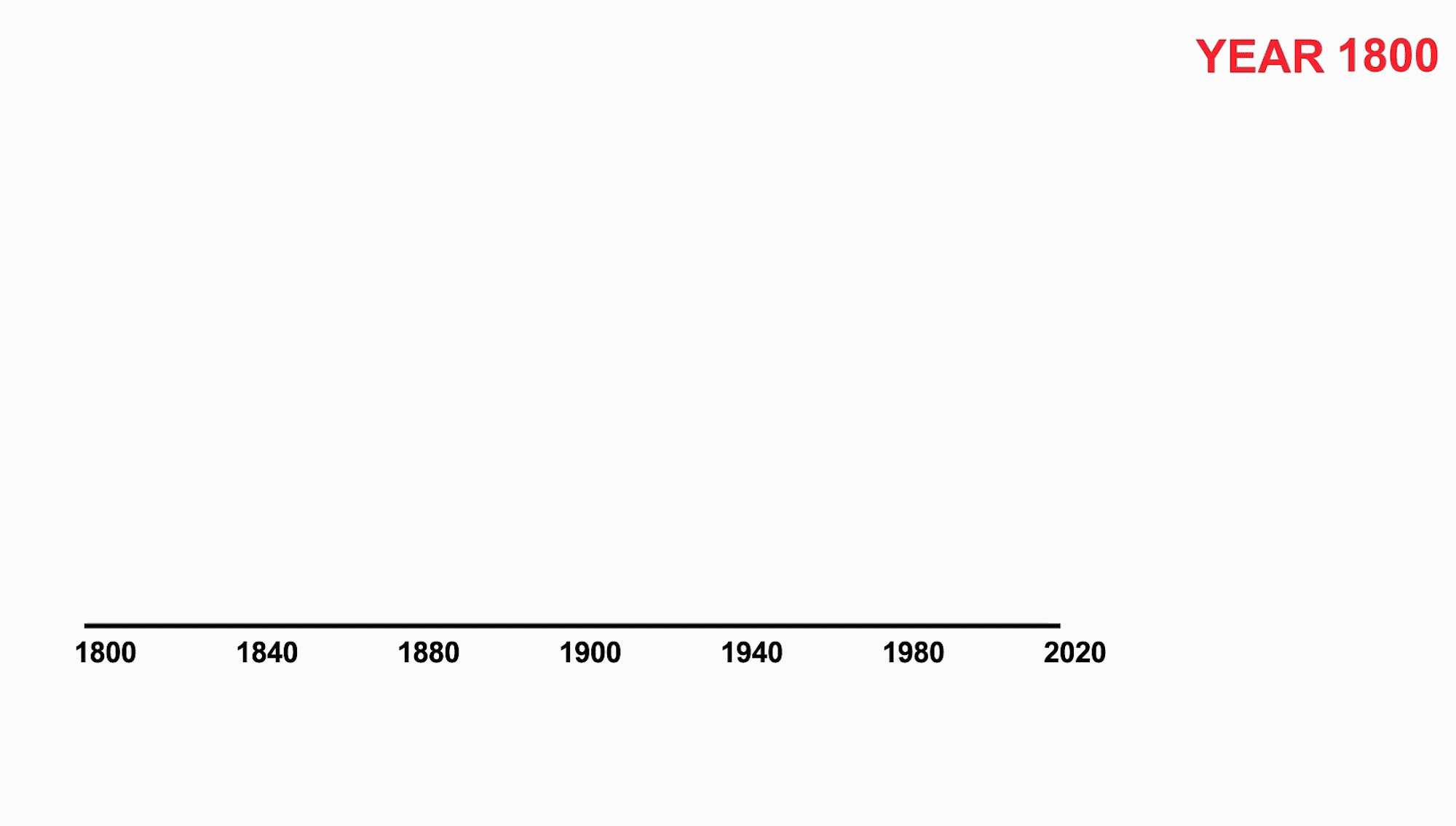
This chart shows them growing together from the start of the nineteenth century to the beginning of the twentieth century. You can see that globally even the British agricultural revolution does not have much impact – the three lines rise at an almost identical rate.
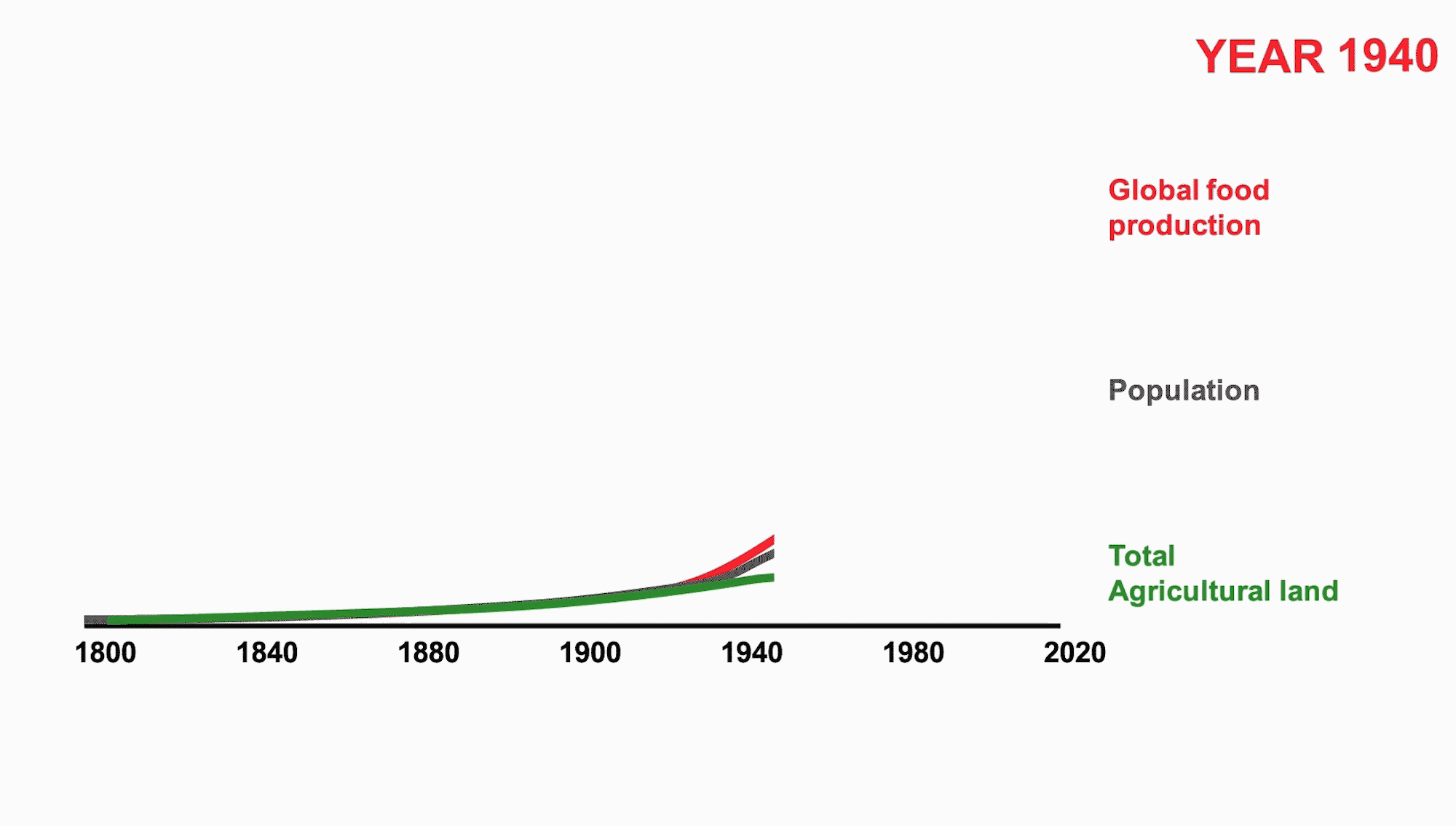
At the end of the war, scientists predicted huge population growth. There simply wouldn’t be enough land to cultivate. Mass starvation seemed inevitable.
But the neo-Malthusians had not reckoned on Norman Borlaug. The botanist had grown up on a small farm in Iowa during the Great Depression. He had seen starving people begging on the streets and rioting over food. It set him on a mission to fight hunger.
Borlaug moved to Mexico in 1944 hoping to develop more productive strains of wheat. He spent his days in the heat-blasted fields, painstakingly crossbreeding wheat plants. He tweezered off stamen, placed tiny hoods over hundreds of thousands of individual heads of wheat, snipped florets and mingled pollens by hand. Completely absorbed in his work, he often slept on the dirt floor of his research hut.
And his efforts paid off. When Borlaug arrived in Mexico, the country’s wheat yields were so low that it imported 60 percent of the wheat it consumed [5]. By 1956 – thanks to his high-yielding, short-stemmed, rust-resistant wheat – Mexico was self-sufficient [6]. This success was repeated in India and Pakistan. Then across the world.
As expected, global population soared. In 1950, the average global life expectancy was 46; today, it is 73 [7]. Infant mortality has plummeted from 1 in 5 in 1950 to 1 in 20 [8]. There are more humans alive on earth than ever before; and yet the threat of mass starvation has receded. The only famines recorded this century have been in countries riven by war or governed by totalitarian regimes [9].
For the first time in agricultural history, the increase in food production, and in calories harvested per person, has massively outstripped the additional land being farmed.
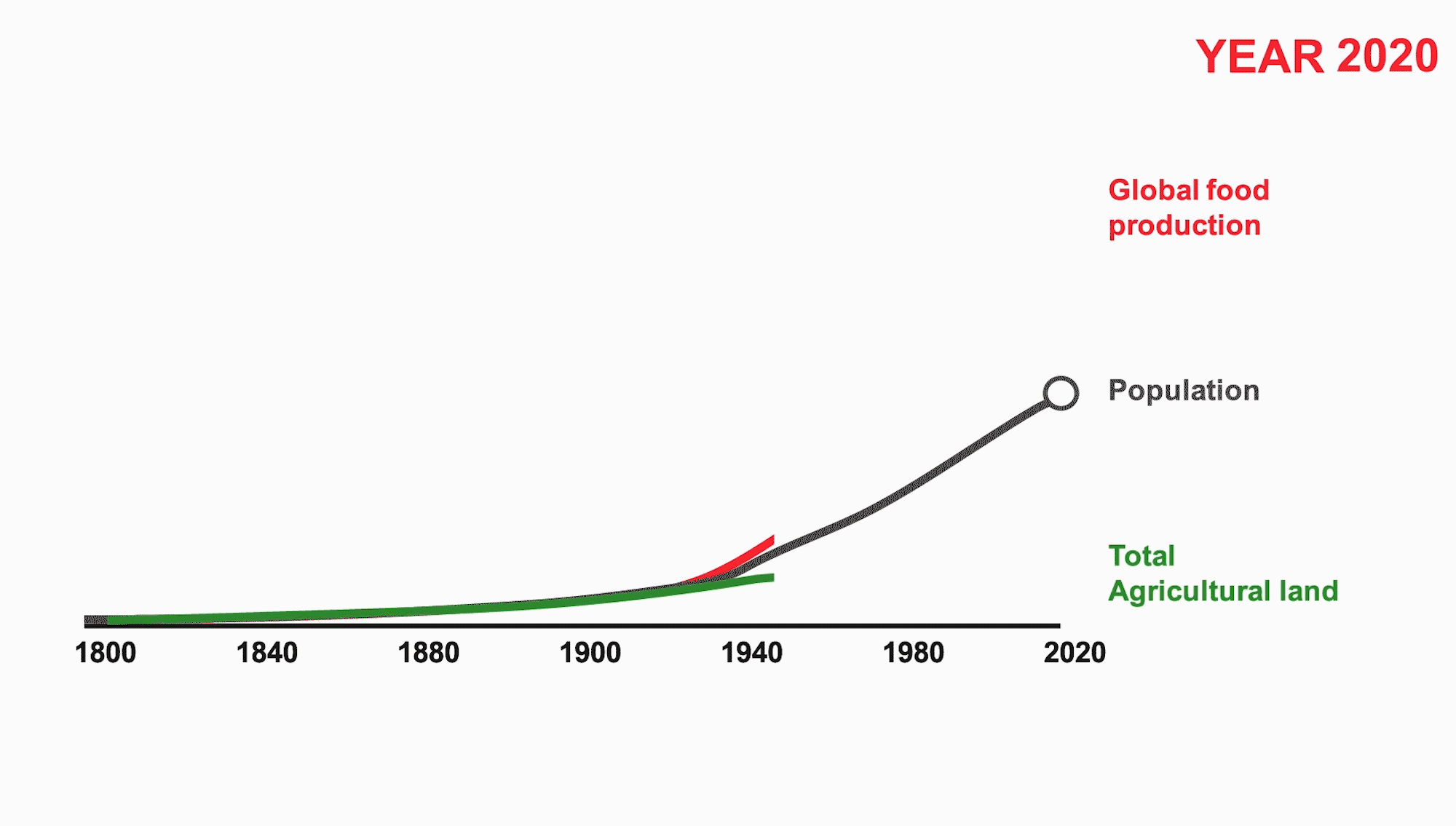
This is what became known as the Green Revolution – by adopting Borlaug’s methods, farmers saved billions of people from starvation. It is poor distribution, not under production of food that now causes hunger.
But as so often happens, the solution to one problem creates others.
As the amount of food available per person increased – and companies found increasingly innovative ways to process, package, and market this surplus – so we have got heavier.
This shouldn’t surprise us. Humans evolved in a world where food was scarce. We evolved to seek out calorie rich foods. We evolved a palate that finds them almost irresistible – and when they are within arm’s reach, we eat more of them. Borlaug’s Green Revolution also made these calorie dense foods – refined wheat, sugar, vegetable fats – abundant and cheaper, which exacerbates the problem.
It shouldn’t surprise us that in the UK you can buy 28 different kinds of KitKat [10]. They are an easier sell than runner beans and therefore a more interesting commercial proposition. 18 of the largest food and drink companies rely on portfolios of food and drink of which 85% are so unhealthy as to be regarded unsuitable for marketing to children under World Health Organisation guidelines [11]. This isn’t a corporate conspiracy, dreamed up by an evil genius bent on making us ill, it is economics. I hope that Roger Whiteside on the panel will give us an insight into the challenges this combination of genetics and economics poses to a company trying to do the right thing by its customers.
In retrospect, we could have foreseen this problem. It has been coming towards us for 70 years – like a tidal wave far offshore – that has only recently made landfall as sufficiently large numbers of us are overweight enough to cause serious health problems and a strain on our National Health Service.
This is shown in this next slide. You can see two charts. On the left-hand side, we have a bell curve representing the distribution of the BMI of the population. The solid vertical line represents a BMI of 30 – defined today as obese. The dotted vertical line represents a BMI of 40 – defined today as severely obese. We start in 1950. You can see on the left that the average BMI then was about 20 [12] – defined now as the borderline between being ideal weight and a little underweight. Evenly distributed either side of that, some people are underweight, some are overweight. On the right-hand side, the chart shows the number of obese adults in the population with time running as the x-axis from 1950 to the present day. In 1950 – you can see from the short bar – very few people are obese.
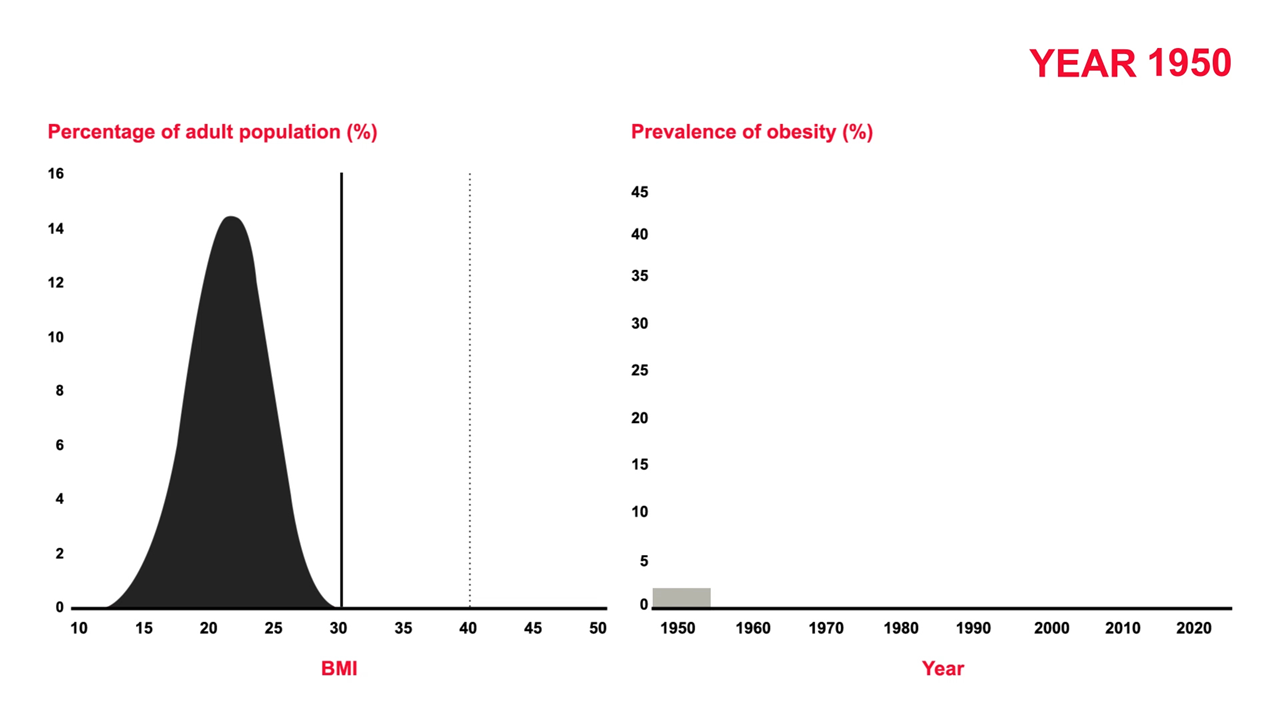
Let’s roll the clock forward slowly to the Eighties. Over time – as food supply increases – you can see the bell curve moves – like that wave – gradually and steadily to the right as the population, gets heavier. And as that happens, the right-hand tail of the bell curve crosses the solid line, and enough of us start becoming obese for that to begin to register on the chart on the right-hand side.
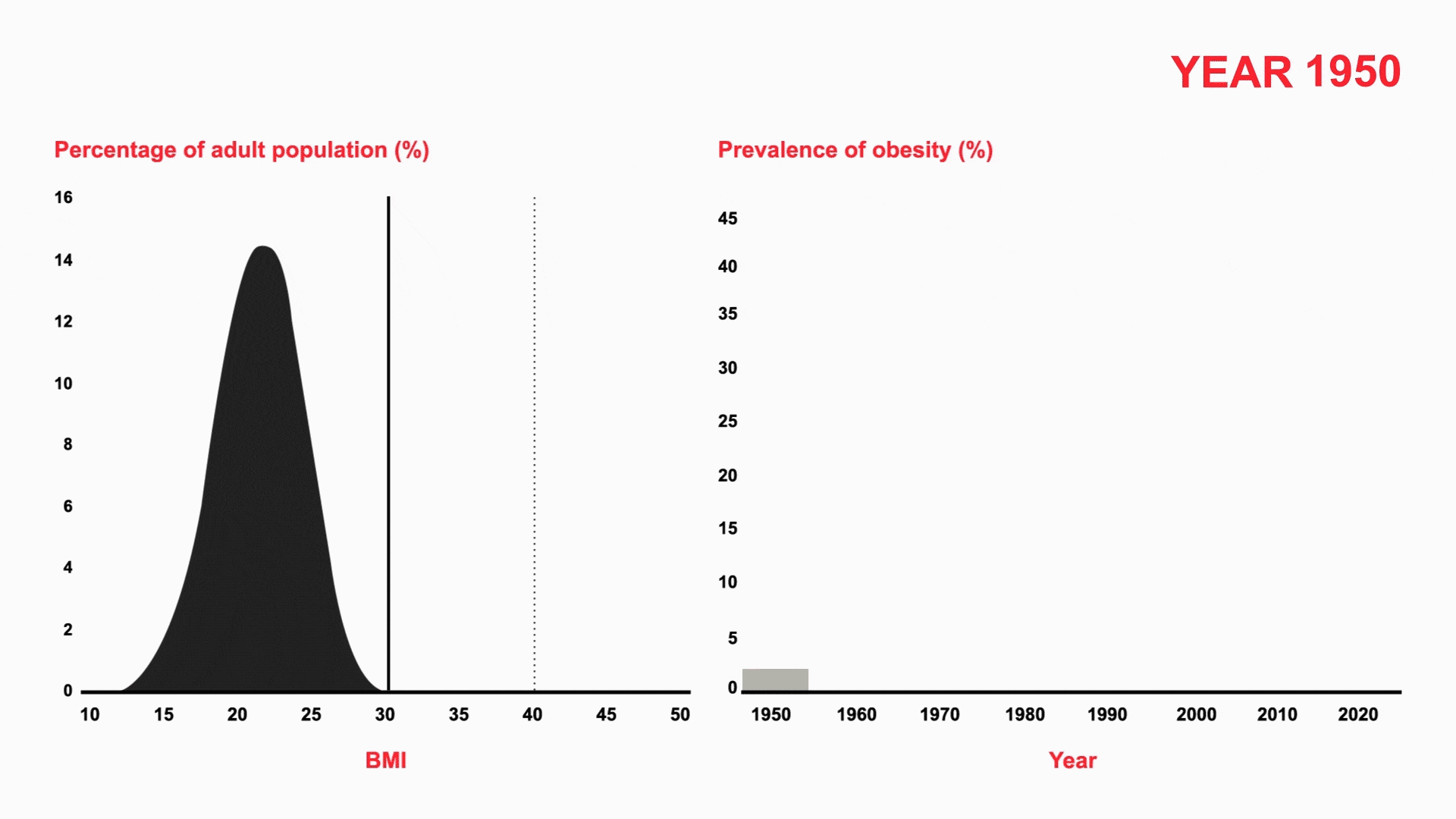
Let’s roll the clock forward again to the current day. You see that the chart on the right starts to steepen sharply. This so-called epidemic isn’t a recent phenomenon. It’s a continuation of a long-term side effect of the Green Revolution, as the increasingly thick part of the bell curve crosses the solid line.
If you look carefully you can see another thing happening. The bell curve stretches creating a long tongue to the right. It seems that some people – those in that tongue – react much more severely to this new food environment than others and so more people are now severely obese than if the curve were a perfect bell. This is a structural problem that is going to get worse.
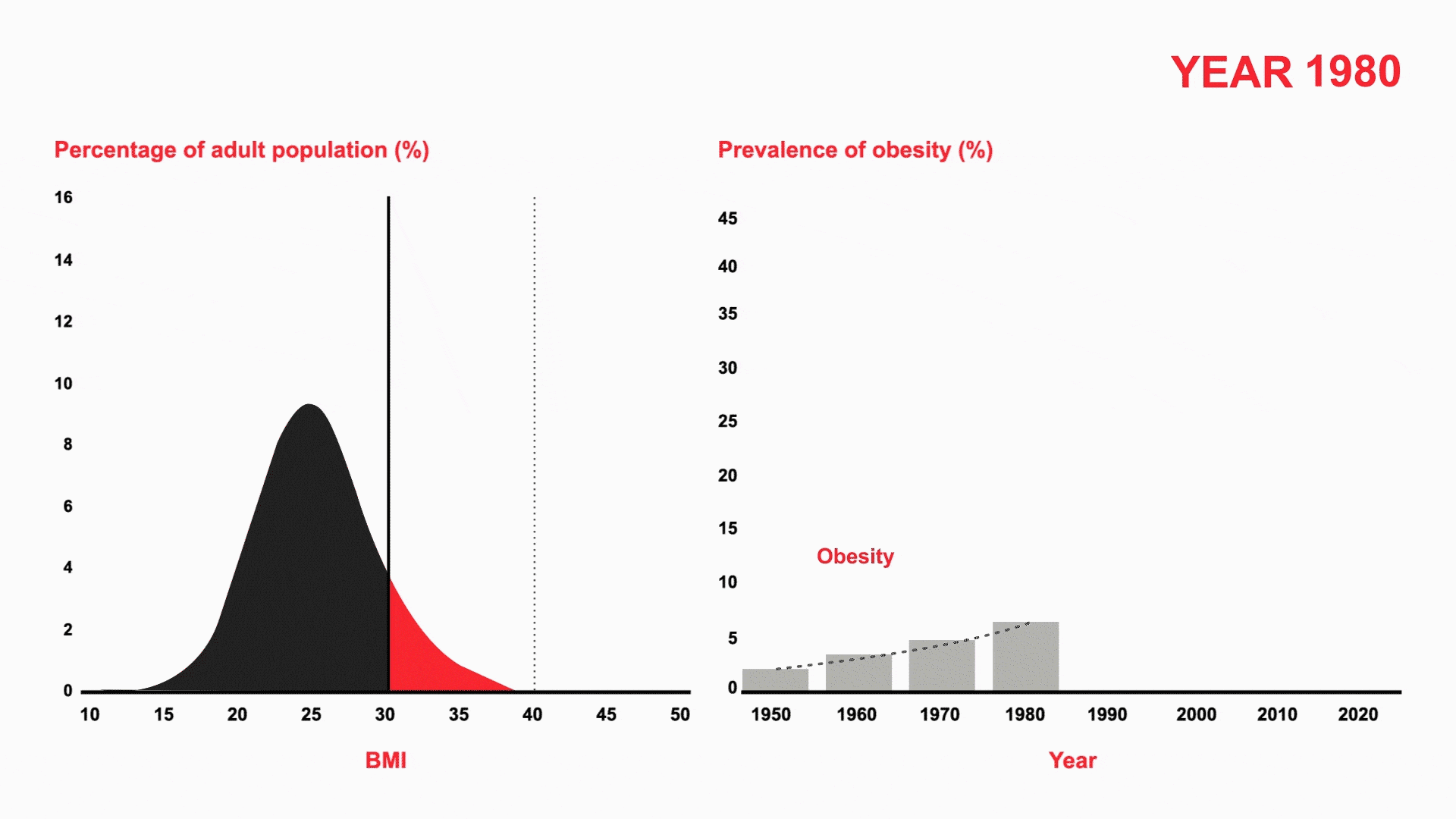
And it isn’t just our health that has suffered. As the amount of food being produced from a given area of land increased, so the amount of other life occupying that same area of land decreased. This chart shows wheat yields in the UK doubling from 1970 to today [13] as the number of farmland birds decreases by 54% [14].
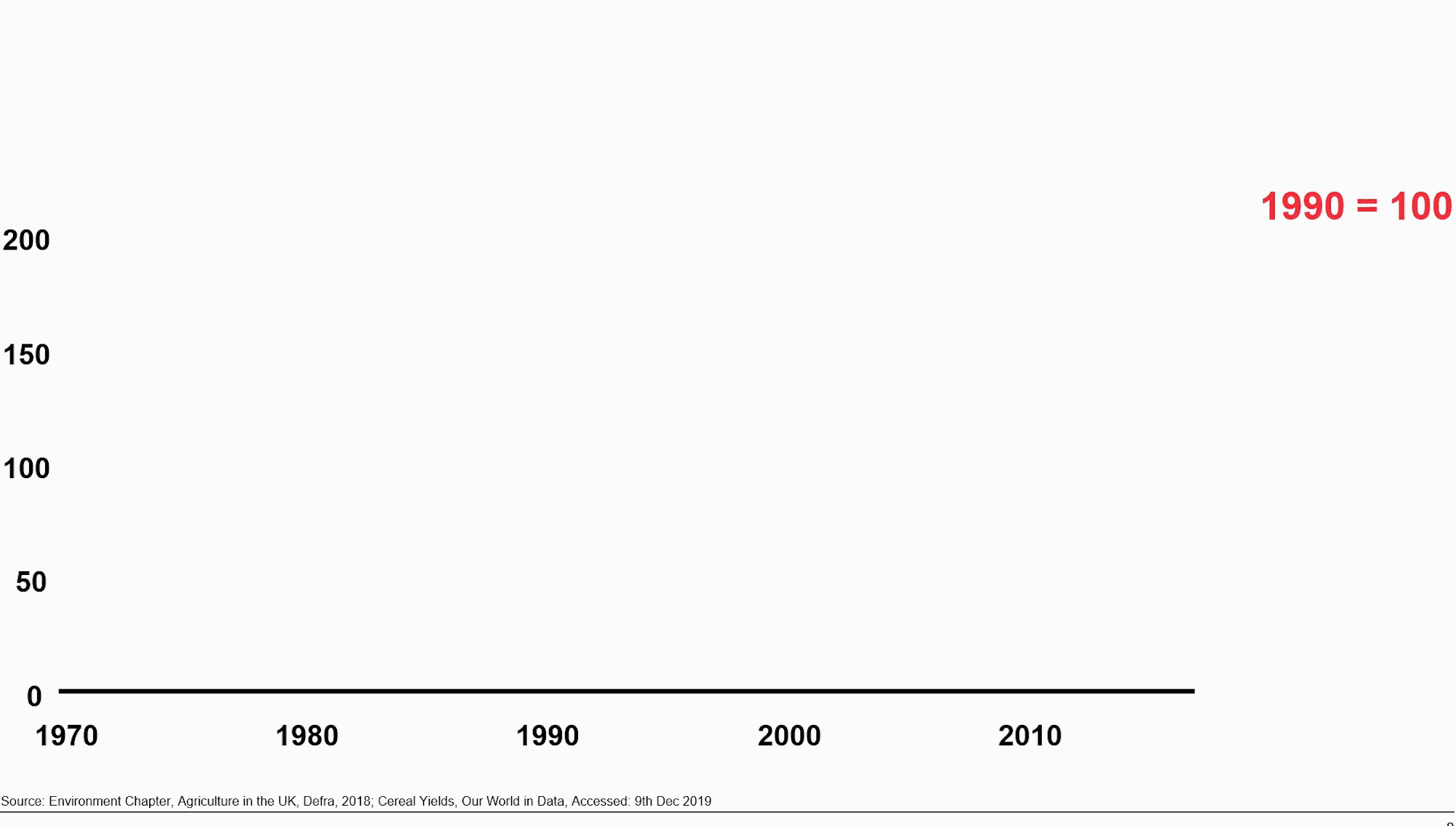
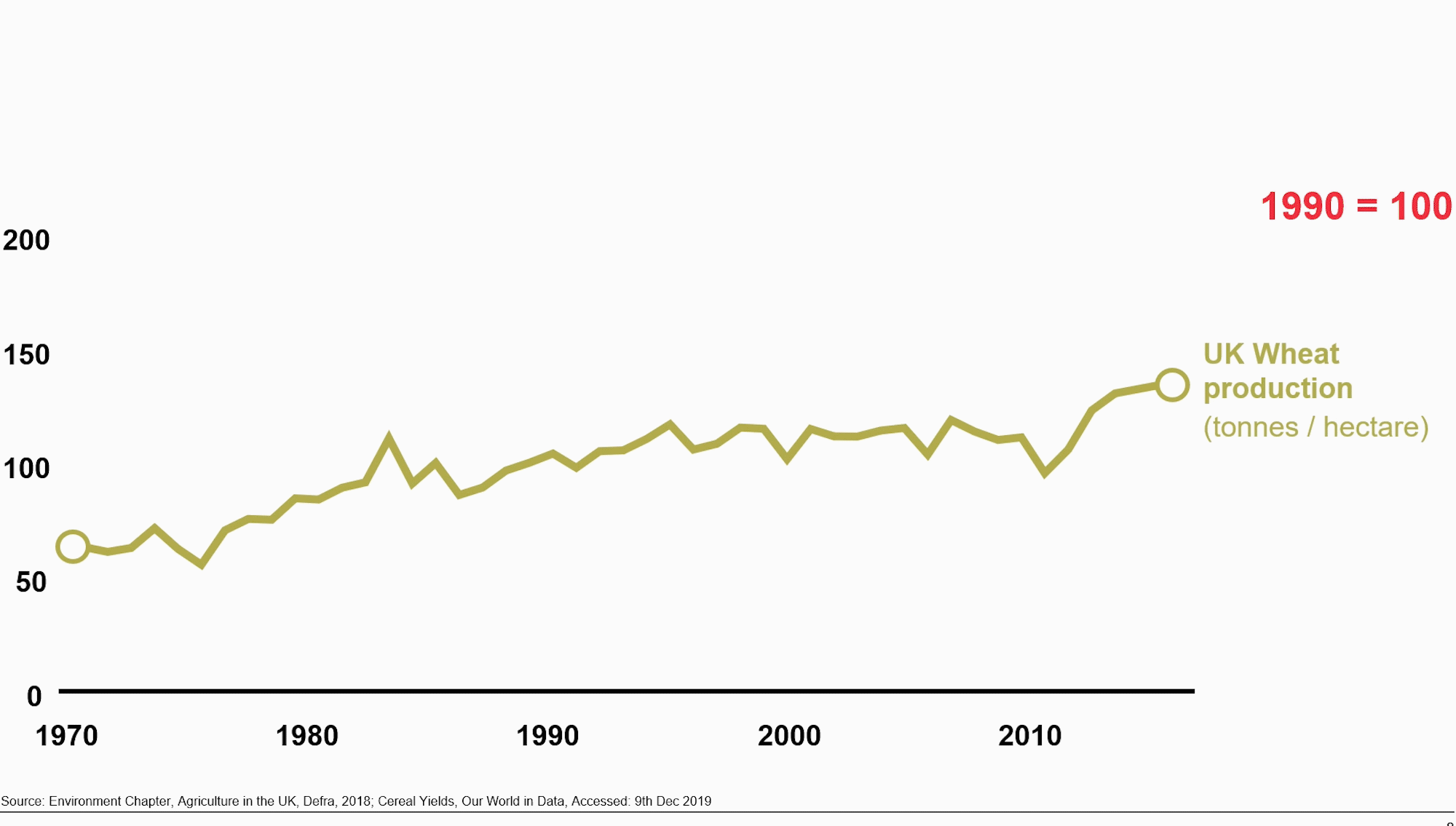
This is just one example (and the problem isn’t restricted to farmland). Of the 6,654 species surveyed in the 2019 State of Nature report, a third had declined in the past 50 years and 1,188 were threatened with extinction. Britain sits in last place on the European farmland bird index. We lost 44m birds between 1966 and 2008. We have lost 99% of our wildflower meadows, half our ancient woodland, three-quarters of our heathland, and three-quarters of our ponds [15].
Finally, we also now know something that Borlaug could not have when he started his experiments. Every stage of the farming process exacerbates the carbon crisis; the forests cleared to plant crops; the energy-intensive manufacture of fertiliser; the release of carbon from degrading soils; the methane produced by rice paddies and livestock; the energy used by manufacturing plants and retail outlets; and the fuel used to power the vehicles in the supply chain. In total the food system is responsible for an estimated 20-30% of total global greenhouse gas emissions [16]. In the UK the food sector emissions represent under 20% of everything we produce [17], but that would rise if you also consider the carbon from the imported food that we consume [18].
We’ve done it once; we can do it again
So, there’s a simple story. We focussed on an existential risk – growing enough food so we didn’t starve – and we largely solved that problem. But as we increased the amount of food available to eat, we ate more and got heavier. And as we got heavier, we got sick.
And as we increased the amount of food we grew on our land, we drove out nature and increased our carbon emissions.
The reason I see this as a story of hope is that it shows that if we know what we want of the system, we can make it deliver. If we can align behind a common vision – as, for our children’s sake, we surely must – we can pivot this system that has been so good at delivering sustenance, pleasure, jobs, and (for some!) profit, to one that does that while simultaneously restoring and enhancing our environment, sequestering carbon, and that stops making us sick.
Understanding the issues
As well as creating a common purpose, there is obviously a lot of detail to work through.
I believe, for example, that we need to start framing the carbon problem as one of both production and consumption. The current production-only climate change targets make no sense. What is the point of doing the enormous amount of work required to create a net-zero farming economy here, if we then just import that carbon from other countries?
The same goes for animal welfare, biodiversity, and environmental pollution. We cannot only consider the externalities of food we produce here but must apply the same standards to food imports. It would be wrong to create a gold-standard for farming in this country and then incentivise those harms overseas in the form of lower standard food imports. It is a red line that as a society we must defend vigorously.
It is a problem, incidentally, not just for us, but for the global trading community. There are enormous legal and regulatory hurdles to overcome and I hope Ian Mitchell will be talking about some of those on the panel in a moment.
We also need to have a more nuanced discussion about the cost of food. The argument is often poorly framed. On one side, you have people who say that our food is too cheap; that the price we pay at the supermarket does not represent the true cost to society as a whole. (In some cases – you might point out – it doesn’t even cover the farmers’ costs). On the other side, people argue that increasing the cost of food would make it even harder for the least affluent to put food on the table. These are two separate issues and should not be conflated. We need to work out what the true cost of food is and separately understand why some people struggle to afford sufficient food. I am not saying that food prices should or will rise; only that environmental degradation or widespread ill health is not a viable long-term solution to the problem of poverty.
But there may be ways the food system can change to help those in poverty eat better. I hope Denise Bentley on the panel will shed some light on how those with scarce resources experience the system today and how it could improve to benefit them.
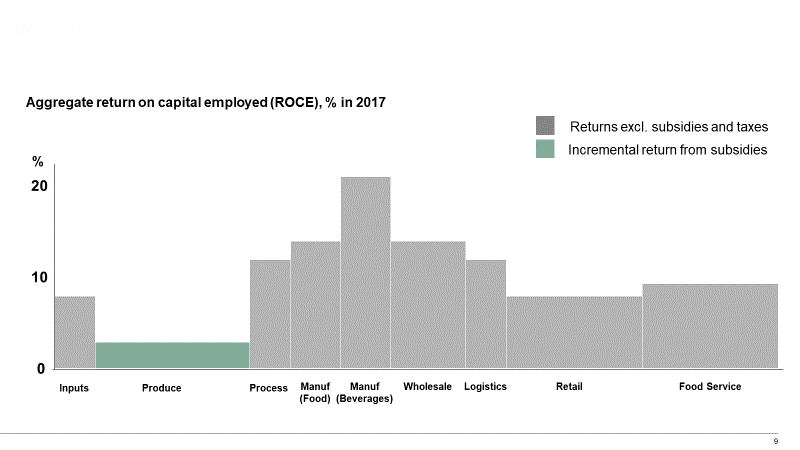
We also need to understand why financial returns are distributed so unevenly across the supply chain. This chart shows the return on capital employed of businesses in different parts of the food sector, from agricultural input suppliers on the left to restaurants and takeaways on the far right. You will not be surprised to see that farming is by far the lowest returning activity. How much of that is caused by oligopolistic power in the market? How much by competition from global markets? How much by our high land prices and relatively high labour rates? And what do we need to do about it to create a genuinely sustainable farming sector?
And, daunting though the prospect is, we will need to take a position on meat. The tone of the debate in this area has been unpleasant. The name calling, and the framing of the argument in terms of goodies and baddies. But worse than the insults, it has become a dialogue of the deaf, with each side making their points increasingly trenchantly and no one listening. Which might be all right, if we weren’t discussing the fate of our children.
We will need to set out clearly the benefits and costs of different production systems – from feedlots on land cleared of rainforest, to cattle reared on permanent pasture or regenerative agro-ecological rotations. And the impact of soy fed to poultry and pork. How does the animal welfare compare in each system? How much carbon does each produce? And how much pollution? We also need to understand the role that ruminants play in our diet, in improving soils and in the broader farm ecosystem. I can only imagine the exasperation British livestock farmers must feel – as they battle with a hugely competitive market and everything the British weather can throw at them – at the total lack of nuance in the debate. We hope to bring a little more light, and a little less heat.
Finally, we will need to think about the kinds of diversity we want in the food system as a whole. In his wonderful book Linked, the physicist Albert-László Barabási describes the characteristics of complex networks (any complex network – the internet, human cells, or the food web). He describes the different ways that hubs and the spokes can be arranged within these systems and shows that small changes in their topography can radically change their characteristics.
Barabási argues that we need to start thinking about nature’s networks in a different way. Until now, scientists have tried to understand nature by disassembling it – breaking matter down into elements and then further into electrons spinning around protons and neutrons, which are themselves disassembled again into quarks for example; or thinking of nutrition only in terms of vitamins and minerals, proteins and fats, carbohydrates and fibre. We have spent “trillions of research dollars” on this project “like a child taking apart his favourite toy”, he writes, and we have no idea how to put it back together again. “We are as close to knowing everything there is to know about the pieces. But we are as far as we have ever been from understanding nature as a whole. Riding reductionism, we run into the hard wall of complexity. . . Nature is not a well-designed puzzle with only one way to put it back together”.
Personally, as someone with an undergraduate degree in Physics and maybe therefore a reductionist by training, I am fascinated by the implications of this. In some ways it is the opposite of Borlaug’s philosophy. He talked about reducing agriculture to a three-component system – good genes, nitrogen, and irrigation.
Barabási would argue that we need to think not just about biodiversity, but the diversity we want in the food system itself – of seeds in seed banks, of crops planted in fields, of foods in our diet, of types of agricultural system, of ports and infrastructure, of local versus global production. This question about diversity will be at the heart of many of the solutions.
Every farmer I have met from the largest commercial farm, to the smallest smallholding, instinctively gets this. I haven’t met anyone who is not deeply invested in finding out more about their soil and about the biodiversity on their farmland and understanding how they use this knowledge to create a more sustainable system.
Emblematic of this, I think, is the gradual coming together of the Oxford Farming Conference and the Oxford Real Farming Conference as people walk between the two creating the kind of links Barabási’ describes in his networks. To tackle today’s problems, we need to combine the best of old wisdom and new science. We need to work together.
I hope that John Shropshire, on the panel, can talk about how he is attempting to make the transition from a narrow definition of productivity to farm in a way that also maximises nutritional density, minimises inputs and carbon emissions and increases biodiversity.
National Food Strategy and Dispersed Leadership
Transforming the food system is a huge undertaking and it is not something that we or government can do alone.
In the spring, as I mentioned before, we will publish our interim report. This will set out a rigorous analysis of the system today, the power structures and economics that shape it alongside a vision of the kind of food system we might aspire to.
We will then look at what needs to happen to get us from here to there. What actions are required from government, business, civil society, and citizens to get us from A to B? What is working well already, here and abroad and what can government do differently to oil the wheels of change.
Some of these questions must be answered not by scientists or economists, but by the people of this country. What do we want our countryside to look like? When it comes to health what role do we want government to play in “helping” us eat a better diet?
Immediately after the interim report, we will be launching in-depth dialogues in every region of the country – within government and with citizens, businesses, civil society and youth. These will culminate in a Citizens’ Assembly towards the end of the year where a randomly-selected, demographically-representative group will debate the evidence and agree recommendations – you can find more detail on all of this on our website. We will incorporate the Citizen’s Assembly recommendations into the final strategy. The government has agreed to respond with a white paper after six months and has asked me to come back to review their progress 12 months after that.
Conclusion
All this may sound daunting. Change is coming. We cannot afford to leave our children a food system that makes them and the planet sick. Government cannot make that change alone, it will require dispersed leadership from across the system – from all of us.
But this is a time of enormous opportunity. In a low-carbon world, we will require much more from our land – we will need it not only to provide food, but materials and renewable energy. We will need it to sequester carbon. Rather than being only a victim of floods, farmers will be paid to help mitigate against them. And to provide different habitats for nature.
These additional demands will inevitably provide opportunities for farmers – the traditional stewards of the land, who know its frailties and capabilities best. And if Britain can lead the world in this effort, we will also be able to benefit by exporting that knowledge abroad.
If you want to be involved in our dialogues, or to become an ambassador for change; if you think you are doing something well and differently that we should see, or simply want to harangue us, please send us your details and thoughts at nationalfoodstrategy.org.
When we faced the last crisis in our food system, our heroes were the farmers who led the way. I believe, and trust, you will do so again.
Thank you.
[1] Defra Food Statistics Pocketbook: The food sector accounted for 14% of GB employment in Q4 2018 – 4.1 million people (including agriculture, fishing and self-employed farmers). https://www.gov.uk/government/publications/food-statistics-pocketbook/food-statistics-in-your-pocket-summary#agri-food-sector-employees-gb-q4-2018.
[2] Population data from Maddison’s historical statistics for 1820-1940: University of Groningen. (2018). Maddison Project Database 2018. [online] Available at: https://www.rug.nl/ggdc/historicaldevelopment/maddison/releases/maddison-project-database-2018; 1800 and 1810 extrapolated from Maddison Project Database; Population data for UN.org. (2015). Population 2030 Demographic challenges and opportunities for sustainable development planning. [online] Available at: https://www.un.org/en/development/desa/population/publications/pdf/trends/Population2030.pdf;
[3] UN.org. (2015). Population 2030 Demographic challenges and opportunities for sustainable development planning. [online] Available at: https://www.un.org/en/development/desa/population/publications/pdf/trends/Population2030.pdf
[4] Defra (2008) ‘Ensuring the UK’s Food Security in a changing World: a Defra Discussion Paper’. London: Defra
[5] Rajaram, S. and Hettel, G. (1995). Wheat breeding at CIMMYT. Mexico, D.F.: CIMMYT, p.iv-v.
[6] ibid
[7] UN Data, 2019. Life expectancy at birth for both sexes combined (years). [Online]
Available at: http://data.un.org/Data.aspx?d=PopDiv&f=variableID%3A68
[8] World Bank data, 2019. Mortality rate, under-5 (per 1,000 live births). Available at: https://data.worldbank.org/indicator/SH.DYN.MORT
[9] Hasell, J. and Roser, M. (2020). Famines. [online] Our World in Data. Available at: https://ourworldindata.org/famines.
[10] Nestle, (2019), KitKat Chocolatory brings premium breaks to the UK, Available at: https://www.nestle.co.uk/en-gb/media/pressreleases/allpressreleases/kitkat-chocolatory-brings-premium-breaks-uk.
[11] Access to Nutrition Index UK Product Portfolio, (September 2019). Available at: https://www.accesstonutrition.org/media/just-released-assessment-healthiness-packaged-foods-and-beverages-uk
[12] Komlos and Brabec (2011) The Trend of BMI Values of US Adults by Centiles, birth cohorts 1882-1986, Economics and Human Biology 9, NBER Working Paper No. 16252. NB: BMI interpolated from US historic BMI trends and UK BMI from 1977 onwards. Distribution before 1980 is directional using normal distributions around mean value and, therefore, is not an exact representations. 1955 is taken as the midpoint for obesity statistic in the 1950s
[13] Defra data, Agri-Food Innovation Paper.
[14] Nbn.org.uk. (2019). State of Nature 2019. [online] Available at: https://nbn.org.uk/wp-content/uploads/2019/09/State-of-Nature-2019-UK-full-report.pdf
[15] ibid
[16] Foodsource.org.uk. (2015). 3.1 What is the food system’s contribution to the global GHG emissions total? | FCRNfoodsource. [online] Available at: https://foodsource.org.uk/31-what-food-system%E2%80%99s-contribution-global-ghg-emissions-total
[17] ibid
[18] WWF (2010), EMISSIONS FROM UK FOOD INDUSTRY FAR HIGHER THAN BELIEVED, WWF, [online] Available at: https://www.wwf.org.uk/updates/emissions-uk-food-industry-far-higher-believed

